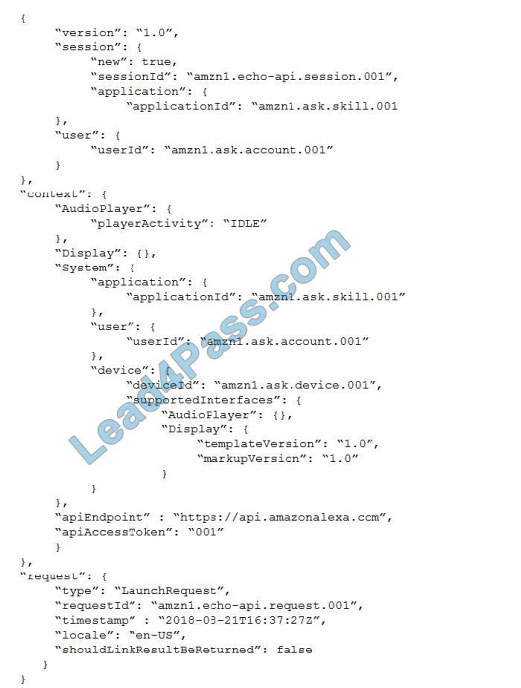AWS Certified Alexa Skill Builder – Specialty exam code: “AXS-C01”. Amazon AXS-C01 exam dumps have been updated.
For complete AXS-C01 exam questions and answers, visit https://www.leads4pass.com/aws-certified-alexa-skill-builder-specialty.html (PDF+VCE). You can choose between PDF and VCE modes to help you successfully pass the exam.
Awsexamdumps updates more AWS Certified Specialty exam questions and answers throughout the year. Follow the AWS EXAM DUMPS to help you pass the exam.
Free Amazon AXS-C01 exam PDF
Amazon AXS-C01 exam PDF is part of leads4pass AXS-C01 exam dumps:
https://drive.google.com/file/d/1Ph0Ak9D-HiZd6KEPXnurcVqXg3SBMMlm/
Amazon AXS-C01 exam questions and answers help you practice the test online
Check your learning level online, all test answers are at the end of the article.
QUESTION 1
An Amazon Alexa skill fetches data for users from a third-party API and the wait for the response from that call is
variable, often taking up to 5 seconds. What is the recommended method for notifying users that a skill is working on the
request and has not failed to respond?
A. Prefetch the data that is expected to the required by the skill from the third-party API using Amazon CloudWatch
Events.
B. Call the Progressive Response API and send a directive, such as VoicePlayer.Speak
C. Ask a follow-up question for clarification to engage the user while waiting for the initially requested response.
D. Respond to the user stating that the data will be ready soon, and upon the next launch of the skill, provide the user
with the response they initially requested.
Reference: https://developer.amazon.com/en-US/docs/alexa/custom-skills/send-the-user-a-progressive-response.html
QUESTION 2
An Alexa Skill Builder wants to customize a welcome back message for each person who uses the skill. The JSON input
is shown below: Which element from the request would the Builder use to accomplish this?

A. sessionId
B. userId
C. requested
D. application
QUESTION 3
An Alexa Skill Builder receives feedback from users that a specific utterance causes Amazon Alexa to trigger the skill\’s
AMAZON.HelpIntent rather than triggering the correct intent and slot. How can the Builder reproduce this behavior to
troubleshoot the problem?
A. Use the AWS Lambda test feature to send a request with the given intent and slot combination.
B. Set up a unit test in the codebase to simulate what happens when the given intent and slot combination are
dispatched within the skill.
C. Use the Manual JSON tab on the Test page of the developer console to see what happens when a request for the
given intent and slot combination is sent to the skill
D. Use the Alexa Simulator tab on the Test page of the developer console to test the utterances the users have
reported.
QUESTION 4
An Alexa Skill Builder is developing a custom skill and needs to verify that the correct slot values are being passed into
the AWS Lambda function. According to best practices, what is the MOST efficient way to capture this information?
A. Add a logging statement to write the event request to Amazon CloudWatch Logs.
B. add an API call to write the environment variables to an Amazon S3 bucket when the function is invoked.
C. Add an API call to read the event information from AWS Cloud Trail logs and add a PutObject API call to write to an
Amazon S3 bucket.
D. Add a statement to parse the JSON request and save it to the local disk for the Lambda function
Reference: https://developer.amazon.com/en-US/docs/alexa/custom-skills/validate-slot-values.html
QUESTION 5
An Alexa Skill Builder has created a taxi hiring skill. The skill needs to find out when the customer wants a taxi, where
the customer is traveling from, and where the customer wants to go. The Builder is currently asking each question
individually, in the following order:
“Where do you want to take a taxi from” “Where do you want to take a taxi to” “When do you need a taxi”
To ensure the voice interaction is flexible, how should this information be gathered regardless of the order in which the
Does the user provide it?
A. Use a single intent and slot. Inspect the incoming slot value and categorize the response, then prompt for the
remaining information.
B. Create an intent for each question and include slots for each piece of information on every intent
C. Create three intents with one slot each. Use Dialog.ElicitSlot to fill the slots.
D. Create a single intent with three slots. Use the Dialog. Delegate directive to fill the slots.
QUESTION 6
An Alexa Skill Builder is developing a custom skill to play a live audio stream. What two built-in intents are required to
implement the AudioPlayer interface?
A. AMAZON.NextIntent and AMAZON.StopIntent
B. AMAZON.ResumeIntent and AMAZON.PauseIntent
C. AMAZON.CancelIntent and AMAZON.ResumeIntent
D. AMAZON.RepeatIntent and AMAZON.StopIntent
Reference: https://developer.amazon.com/en-US/docs/alexa/custom-skills/audioplayer-interface-reference.html
QUESTION 7
An Alexa Skill Builder is creating a skill that will identify an actor who spoke a famous piece of movie dialog, given just
the dialog text and an optional movie name. The Builder created the FindActorIntent as shown below, but Amazon Alexa returns an error when it builds the model.

Why is Alexa failing to build the model?
A. Intents can have one built-in slot type only
B. All sample utterances within an intent should have both slots
C. SearchQuery is combined with another intent slot in an utterance.
D. “Dialog” is a reserved keyword in the Alexa Interaction Model schema.
Reference: https://forums.developer.amazon.com/questions/112932/got-error-code-invalidintentsamplephraseslot.html
QUESTION 8
An Amazon Alexa interactive story skill needs to provide users with the option to resume the skill from where users left
off when they last used the skill. Where should the data be stored to ensure that the skill will start at the correct
location?
A. In a JSON file along with the skill\’s AWS Lambda function
B. In Amazon DynamoDB
C. In the skill\’s session object
D. In the skills\’s request object
Reference: https://developer.amazon.com/en-US/docs/alexa/in-skill-purchase/add-isps-to-a-skill.html
QUESTION 9
An Alexa Skill Builder built a skill using AWS Lambda. The Lambda function works when running the code on a local
machine with a runtime of 4.5 seconds, but during skill testing, the Builder receives an error response. Which collection
of steps will address the issue? (Choose two.)
A. Change the Amazon Alexa default timeout to 5 seconds.
B. Change the default timeout of the Lambda function to 5 seconds.
C. Call the Progressive Response API and send a directive to reduce latency.
D. Increase the size of the memory allocated to the Lambda function.
E. Clone the Lambda function to another AWS Region.
QUESTION 10
An Alexa Skill Builder needs to set up an Amazon Alexa skill beta test. What user identifier should be used to add beta
testers?
A. AWS account number
B. Alexa user email address
C. Amazon vendor ID
D. Amazon customer ID
Reference: https://developer.amazon.com/en-US/docs/alexa/custom-skills/skills-beta-testing-for-alexa-skills.html
QUESTION 11
During testing of a new Amazon Alexa skill, the skill is repeatedly failing and invoking the function defined in the
add error handler method specified on the SkillBuilder object. Upon inspection of Amazon CloudWatch Logs, the Alexa
Skill Builder establishes that the failure is occurring whenever AMAZON.HelpIntent is being received.
How should this error be corrected?
A. AMAZON.HelpIntent should be handled by the SDK. The Builder should raise a support ticket with Amazon.
B. The Builder should ensure that the intent handler is coded so that it tests for AMAZON.HelpIntent in its canHandle
method, and when detected, returns true.
C. The Builder should add logic to provide helpful instructions to the function defined in the add error handler method
specified on the SkillBuilder object.
D. The Builder should add an AMAZON.HelpIntent entry to the interaction model to ensure the request for help is
recognized by the skill.
QUESTION 12
An Alexa Skill Builder is developing a skill that enables users to purchase train tickets. The Builder wants to give users
the ability to modify the departure time if they are misunderstood before the skill proceeds to purchase the tickets.
Which option should be used to implement this functionality within the session?
A. Implement AMAZON.FallbackIntent so the user can stop the execution when they have been misunderstood.
B. Implement AMAZON.StopIntent so the user can stop the execution and implement a prompt with a new invocation of the skill.
C. Implement AMAZON.CancelIntent so the user can cancel the order, then set shoulder session to false, and prompt
the user for the next action.
D. Implement the welcome message, providing clear instructions to the user describing how to format an order.
QUESTION 13
An Alexa Skill Builder adds a colleague to a skill using the beta test feature. The colleague logs in to the developer
console to edit the interaction model and cannot see the skill. Why is this happening?
A. The colleague needs the ROLE_ADMINISTRATOR enablement.
B. The skill was not submitted for publishing.
C. The colleague was not made an administrator in the beta test tool.
D. The colleague has not been added to the skill\’s developer account.
Reference: https://developer.amazon.com/en-US/docs/alexa/custom-skills/skills-beta-testing-for-alexa-skills.html
Publish the answer:
| Q1 | Q2 | Q3 | Q4 | Q5 | Q6 | Q7 | Q8 | Q9 | Q10 | Q11 | Q12 | Q13 |
| B | A | B | D | D | B | C | C | BE | B | B | C | C |
How is your test effect? I hope you get full marks. The free Amazon AXS-C01 exam practice questions are part of the leads4pass Amazon AXS-C01 exam dumps.
Get the complete Amazon AXS-C01 exam dumps https://www.leads4pass.com/aws-certified-alexa-skill-builder-specialty.html (Total Questions: 65 Q&A). Successfully passed the exam 100%.
Once again, Amazon AXS-C01 is one of the AWS Certified Specialty exam certifications. You can click to view more related exams.
ps.
Amazon AXS-C01 exam PDF is part of leads4pass AXS-C01 exam dumps:
https://drive.google.com/file/d/1Ph0Ak9D-HiZd6KEPXnurcVqXg3SBMMlm/
